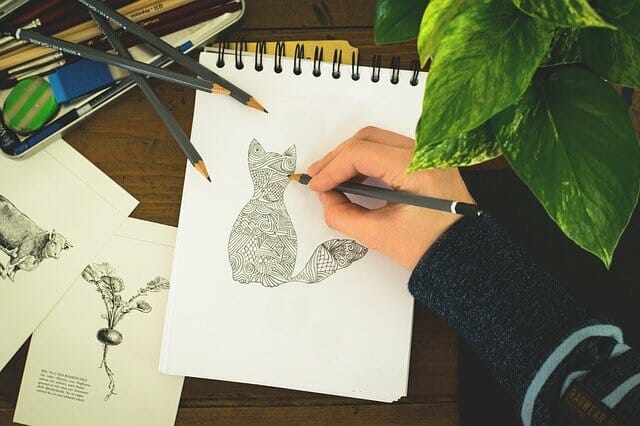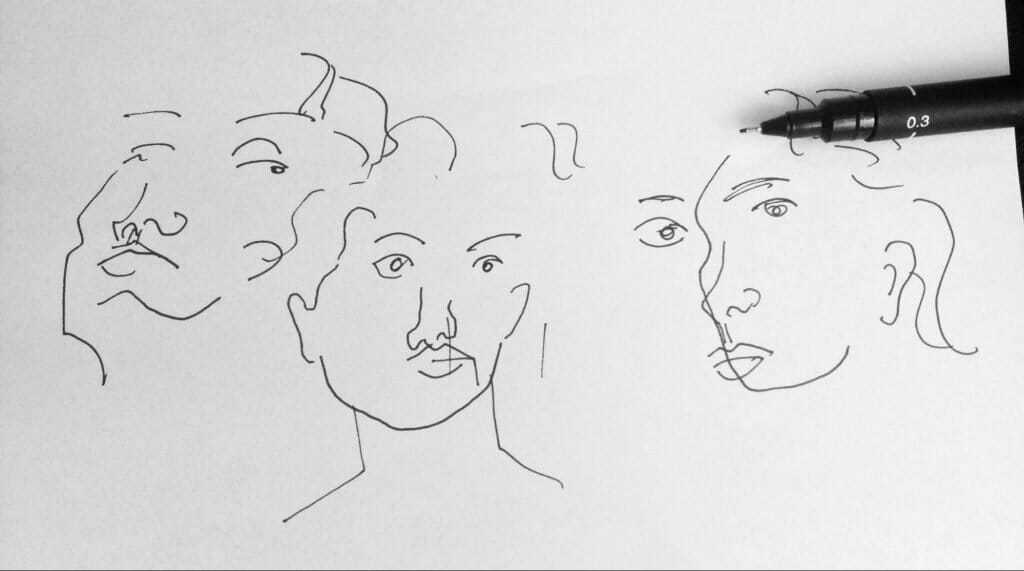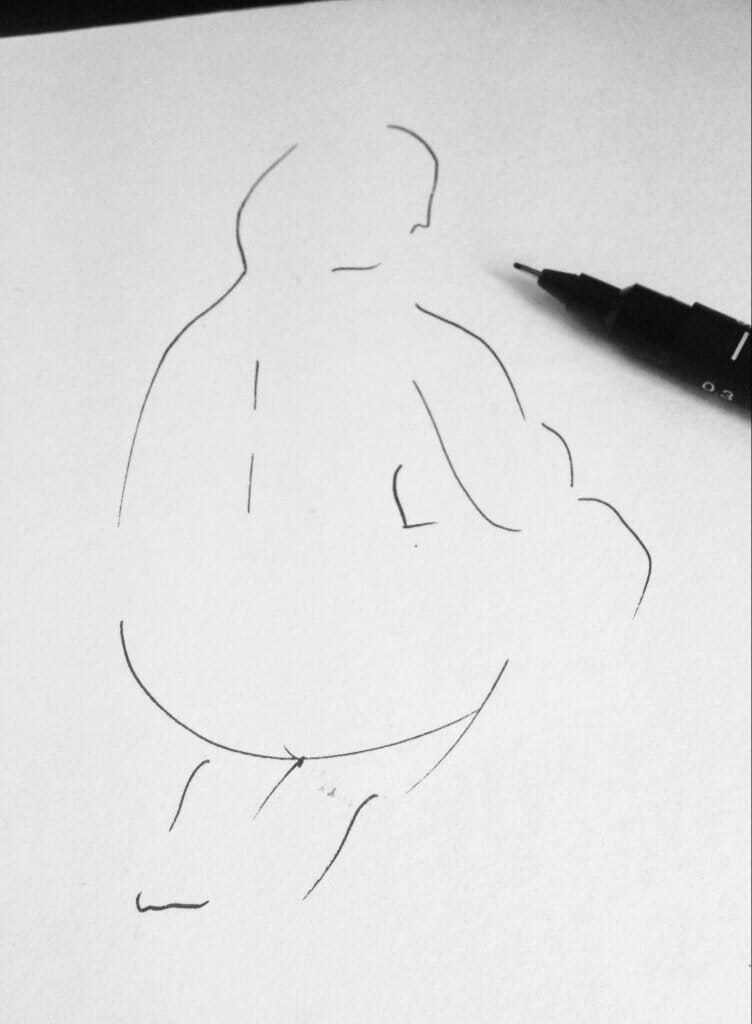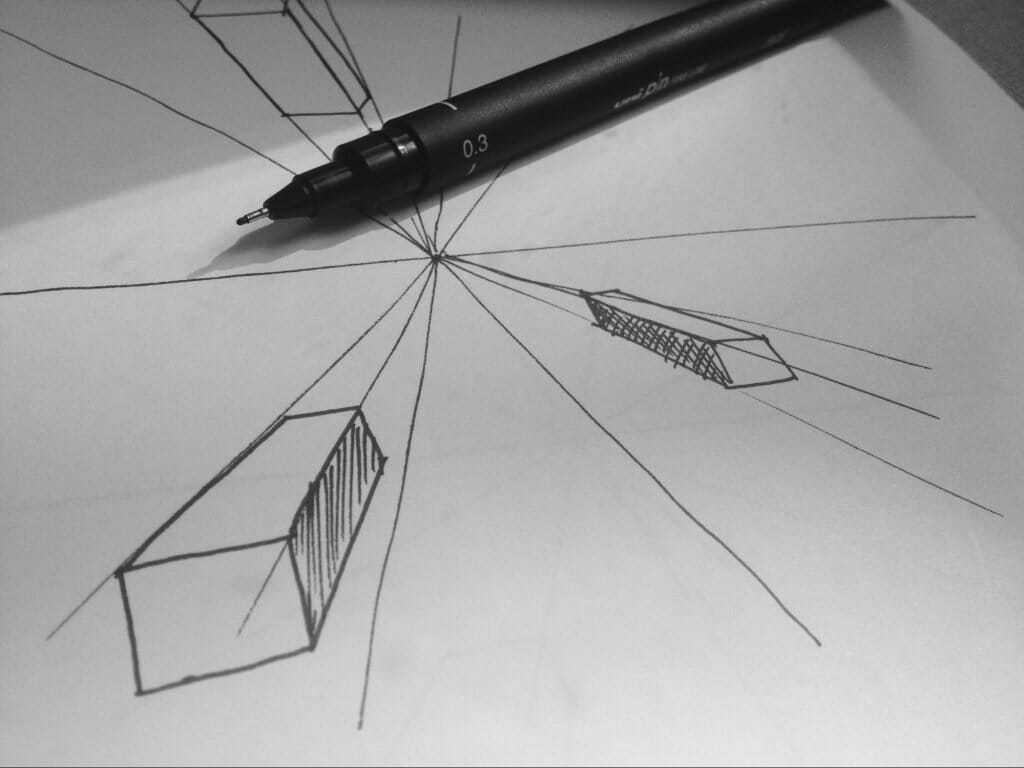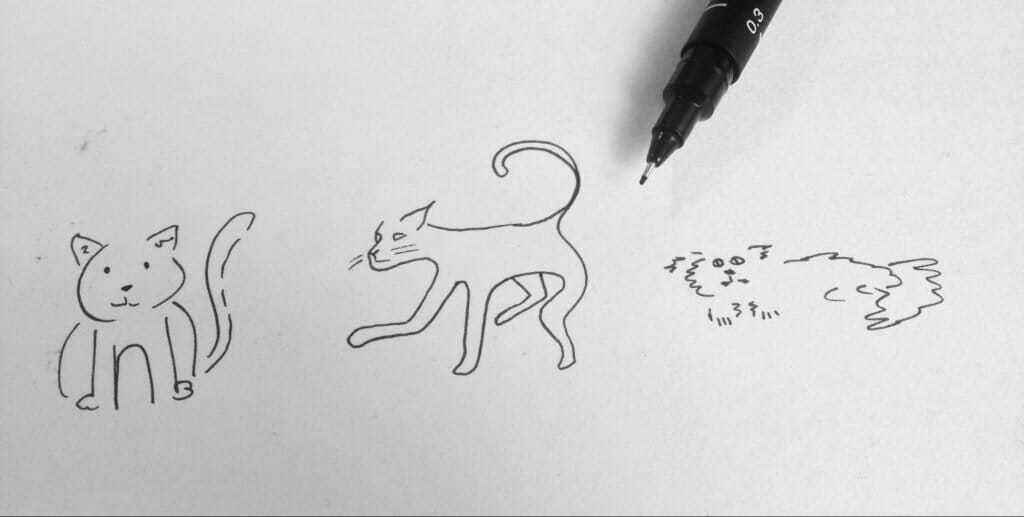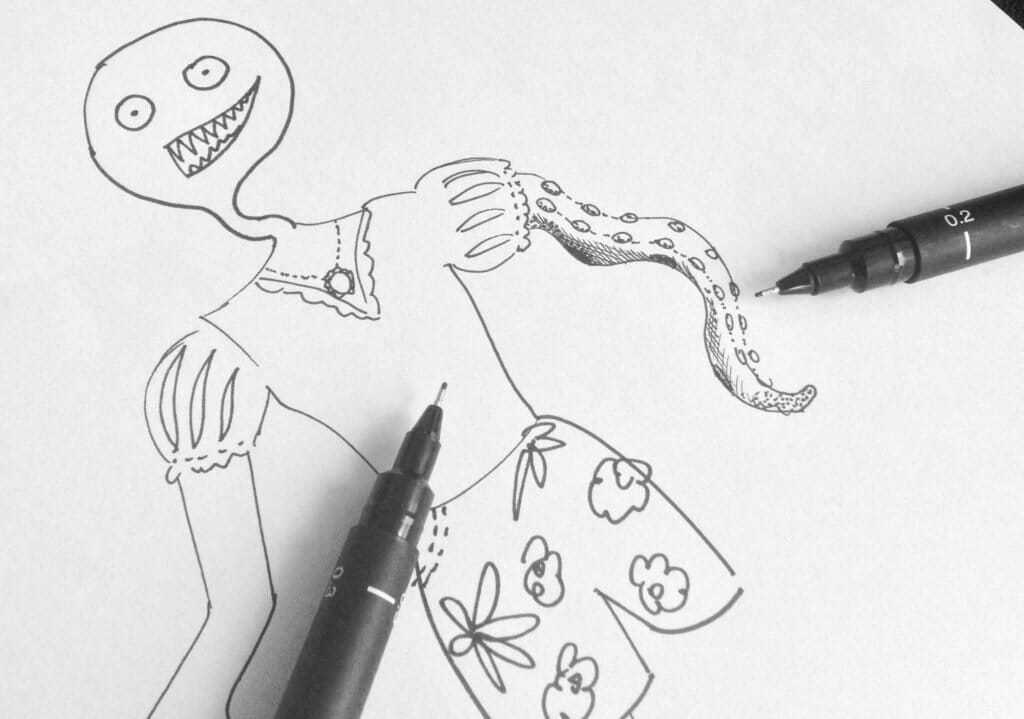Do you struggle to draw the simplest of shapes? Or are you a seasoned
artist who wants to go from good to great? Whatever your level, the
drawing tips that follow will help you take your skills to the next
level.
We dig deep into the science of
how to draw better to uncover ways you can slowly but surely improve your drawing skills over time.
Practice makes Plastic - Harness Neuroplasticity to Improve your Skills
Since the 1970s, scientists have developed the now-standard theory of ‘
neuroplasticity’ to describe learning and brain development in adults. Simply put, neuroplasticity means that our brains
change their shape and structure as we learn new skills and information.
The
more we practice a skill, the more our brain physically rearranges
itself, strengthening the neural pathways which are required by that
skill. This means that the more we draw, the more our brains optimize
themselves for drawing. The messages for budding artists is simple - go
forth and practice!
However, simply practicing blindly and stacking up drawing hours may not be enough.
A scientific study into the development of drawing skills in students found that the best learners used a ‘strategic’ approach to learning.
These
students identified their weaknesses, and found tried-and-tested
methods to practice and improve them. They also tracked their the
progress of their skills, and updated their practice methods
accordingly.
The rest of this article outlines techniques for
improving your drawing style, which you can apply strategically and
practice often to plastically mold your brain into that of an artistic
whizz.
Bottom line:
As with all skills, our brains adapt
better to drawing the more we practice it. But it also helps to identify
your weaknesses and focus your learning to improve them, as this will
speed up your learning curve.
2. Get your eye and hand in sync
Scientists researching how humans draw have identified
four factors that determine a person’s drawing abilities.
These
are: 1) how well someone perceive objects, 2) how well they remember
visual information, 3) what decisions they make as they draw and 4) how
well they can coordinate their eyes and hands.
The latter -
hand-eye coordination - is the most obvious, and is something beginners
often struggle with. Luckily it’s very easy to practice!
Psychologists have long known
how motor skills are improved.
Performing a simple but challenging action repeatedly until it is
mastered fixes it in the brain and makes it easy to recall for a long
time later. As we learned previously about brain plasticity, this is
because neural pathways are being physically strengthened within the
brain.
Hand-eye coordination can therefore be improved by
performing drawing exercises which are simple and easy to perform
repeatedly and frequently, but provide tough challenges for hand-eye
coordination.
To practice your hand-eye coordination when drawing
from life, try ‘blind contour drawing’. Fix your gaze on the object you
are drawing, and sketch it
without looking at the paper.
This
is a common trick used by artists to improve their hand-eye
coordination skills. A few sessions of blind contour drawing can also
help warm up at the beginning of a drawing session and get your hands
and eyes in sync.
If you want even more of a challenge, you can try a variation of the ‘mirror drawing test’.
Mirror drawing is standard scientific test
used in many studies on motor control skills learning and psychology, because of the unique challenge it presents for hand-eye co-ordination.
In
the traditional laboratory setup, test subjects are asked to trace the
outline of a star on a piece of paper. Their direct view of the paper
and their drawing hand is blocked, but they are able to watch a
reflection of the picture that they are drawing.
To practice this
trick at home, prop up a small mirror beside you as you draw, and force
yourself to only look down at your drawing through the mirror. The
exercise will be challenging, but worth it for the coordination benefits
it brings with repeated practice.
Summary
To improve your
hand-eye coordination, try co-ordination challenges like blind drawing
(drawing without looking down at the picture) and mirror-tracing
(drawing while looking at a reflection of your drawing hand).
3. Fine tune your motor skills
Particularly
if you like using a textured medium like painting, chalk, charcoal, ink
or soft pencil, another crucial aspect of motor control in drawing is
how to control the marks your drawing tool makes on the paper.
As
all amateur painters know, different applications of pressure or angle
can give vastly different textures or brushstrokes. As with blind
contour drawing, the skill of working with tools can be molded
plastically into our brain through practice.
A simple technique to
improve your tool work which you can practice every day is simply to
draw a series of straight lines, of equal width and a fixed width apart.
Try to make the lines as uniform as possible - totally straight, the
same thickness, and the same spacing between each line.
Slowly,
your hand will learn how to control the tool in order to get the best
line possible. This knowledge will be unconsciously absorbed,
strengthening neural pathways and allowing these motor control skills to
emerge during all the drawing you do.
Research has shown
that the development of motor skills requires periods of rest between
practices, when our brains can gather together and act on the
information. Therefore it’s best to do this exercise little and often -
practice it just once a day for as long as you can.
The bottom line:
Motor
control skills are also important in the direct action of your tool on
the paper. If you like work with a particular art tool - like a brush or
chalk or
embroidery machine - spend a short time every day drawing straight, precise lines to teach your hand the motor skills to control it.
4. Work on your short term drawing memory
Though
it is the most obvious skill associated with drawing, hand-eye
coordination is only part of what makes someone good at drawing.
Scientists have found that artistic skills are dependent not just on our
motor skills, but on our memories.
A study of 277 art students by University College London found that students with high artistic ability also had good visual memory.
When
an artist draws something from memory or their own imagination, it
obviously helps for them to be able to remember shapes and colours
strongly.
But even when sketching real-life objects, a good visual
memory helps the artist keep an image clear in their mind when they
look down from their subject to the page. Without good short-term
memory, their image of the object becomes muddled even in the short time
it takes to glance down at the paper and sketch a few lines.
This
may explain why many novice artists are frustrated when they look back
up at their subject and find that it looks very different to what they
have just drawn.
This type of short term memory is often distinguished in cognitive science by a separate term - ‘visualization’, or ‘
working memory’.
This is because the memory formation and recall occur so quickly they
are almost unconscious, and they are not usual encoded to long-term
memory.
This means that - luckily! - one does not need a perfectly
photographic memory to be good at drawing. All one needs is an accurate
enough working memory to keep a image in one’s head for a few seconds
and commit it to paper.
A quick and effective way to improve your short-term working memory is the Copy Game. The game is simple:
- Find an image
- Look at it for 30 seconds
- Cover it up
- Draw it
When
starting out, give yourself long time intervals (for example 30-40s)
and use simple cartoon images. As your technique gets stronger, you can
shorten your time and progress to more complex line drawings and
photographs.
As with previous activities, the best way to pick up
skills is to do them frequently in small amounts, over a long time. Work
a quick version of the ‘copy game’ into your drawing routine or
practice it every day.
No pen and paper to hand? Is there a way to improve your drawing even while crammed onto the subway?
There are a number of apps to hand which can help to improve your short term memory. In particular, a visual memory trainer by
BrainHQ has been proven in
an independent scientific study
performed by UCSF researchers to help increase visual memory. Look in
particular for its ‘mind’s eye’ app, which is specifically designed to
target short-term visual memory.
Working at training your visual memory often is even more important as you get older.
A study of over 55,000 individuals
from the ages of 8 and 75 showed that short-term visual memory peaked
at age 20 and declined sharply afterwards, with 55 year olds displaying
even lower scores than 8 and 9 year olds. Fortunately, skills can be
improved with practice at any age.
The bottom line:
Training
your visual memory helps train your drawing skills. Boost these by
playing a simple game of drawing images from memory, or downloading an
app designed to aid short-term visual memory. Pay particular attention
to this skill as you get older.
6. Learn what to choose
So
you’ve learned to precisely control your hands, and fine-tune your
visual memory. But there’s another crucial step which takes place
between looking and drawing.
Several studies in drawing and
cognition have found an intriguing factor which seems to distinguish
good artists from bad: ‘visual selection’.
Real-world objects are
infinitely complex, with countless dimensions, colours, shadows and
planes to consider. When representing an object on paper with a small
number of marks (i.e. when drawing!) the artist has to carefully select
which parts of the object to emphasise and which to leave out.
Two studies (
Kozbelt in 2010 &
Ostrofsky
in 2011) found that good artists were able to quickly identify the most
important lines in a drawing. This allowed them to make an instantly
recognizable image with a minimum number of lines.
Visual
selection in one of these studies was evaluated using an unusual
exercise: tape tracing. Participants were given a photograph of an
elephant and asked to place a sheet of tracing paper over it. They were
then given a number of short pieces of tape and asked to trace the shape
with them. The photographs were then removed and the resulting ‘tape
traces’ evaluated by independent observers.
The most skilled
artists used their tape to identify the most important features of the
elephant picture, including strong shadows and lines, while less skilled
artists usually traced the outline of the picture without including
relevant detail, or focused on ‘obvious details’ like the trunk and
tusks, rather than key lines.
If you like, you can try the tape tracing game yourself to see how good your skills at visual selection really are.
An
easier (and perhaps more enjoyable) technique, however, is simply to
try to make a drawing using the least amount of ink (or pencil, or
paint, or
3d pen strokes…) possible. Forcing yourself to be minimalist helps practice and reinforce selection skills.
If you have trouble keeping yourself to a few lines, try some timed drawing practices. Sit at your
home office desk,
give yourself 30 seconds to look at an object, and identify the parts
of it which will be the most important to represent. Then spend the
remaining 30 seconds drawing, not letting yourself make any last-minute
embellishments.
The bottom line:
Good artists know what the
most important parts of an image are to include. To hone this skill,
practice creating an image with as few lines as possible.
7. Practice ‘Switching your Levels’
Identifying
the most important parts of an object might help the artist plan their
drawing. But these ‘important parts’ come in all sort of shapes, sizes
and types.
The crucial parts of an image might range from the huge
and general - like an object’s overall shape - to the small and
delicate - like an important detail or texture.
A
2015 study
found that successful artists had a high ability to switch between
different ‘levels’ of an image, specifically between detail and general
shape and form.
A good way to practice your visual level-switching
is a parallel-drawing technique. Take an object with a strong external
shape, and a detailed texture - say, for example, a sofa.
Take two
sheets of paper and lay them parallel in front of you. On one, draw a
sketch of the shape of the object, trying to get the large-scale form
and dimensions as accurate as you can.
On the other, focus on
shadows, patterns and textures, and try to capture minute and subtle
details. Switch between the two every few seconds.
As you
practice, you can start to work this technique into a single drawing.
When you are drawing an object from life, consciously switch between
focusing on the details and on the ‘big picture’.
This mimics the process used by professional artists, who keep their mind flexible while creating an object on paper.
Summary:
Learn
how to ‘switch levels’ when drawing between large forms and shapes and
small details. Train at first by switching between different drawings,
and then consciously switching as you draw.
8. Play the ‘’perspective’’ game
Another
extremely important quality of artists is high capacity for ‘object
constancy’. This is defined by cognitive scientists as the ability to
recognise an object even if it is tilted at an angle or moved closer or
further away.
A
1997 study
found that the most common cause of inaccuracies in drawing is not the
artist’s motor skills or the decisions they make when drawing, but in
fact their initial perception of the object. A
further study in 2008 tested participants on an object-constancy test and found that those with a higher score had better drawing ability.
The
biggest challenge in object-constancy for novice artists is often
perspective. How do you distinguish between a small object which is
close, and a large one which is far away?
Many
art books and classes have a section on artistic perspective. This is a
set of techniques, developed originally by Renaissance Italian artists,
to give pictures a three-dimensional quality.
This technique
involves drawing a ‘horizon line’ in a picture. Several ‘’vanishing
points’ are defined on this line, and straight lines drawn emanating
from these vanishing points.
Some useful guides to perspective drawing are available
online.
This
may seem a very technical and time-consuming way to approach drawing,
but the good news is that you may not need to use this elaborate
technique forever. Thanks to neuroplasticity, as with many other skills,
the ability to draw in perspective will stick in your mind with enough
repeated practice - something also proven by a separate
scientific study.
One study
has even suggested that drawing an object from multiple angles and
perspectives has a positive effect on spatial ability in general, even
beyond drawing.
To speed up your instinct for drawing in perspective, practice drawing small sketches on a perspective grid.
Draw a perspective grid on a piece of paper (or download some
pre-drawn perspective grids) and choose a simple object like
office furniture. Draw it at different points on the perspective grid and see if you can make it look like the same object.
As
you build up your abilities you can try moving more and more complex
objects around a perspective grid, and consciously try to incorporate
the rules you learn into your drawings.
Summary:
Practice
manipulating and scaling objects using a perspective grid to build up
your instincts for ‘object constancy’ and how objects are positioned in
space.
10. Practice scaling your drawings
This
exercise may seem simple, but it involves many of the factors already
mentioned - hand-eye coordination, visual memory and shape constancy.
Take
two different sizes of paper, and draw the same object on them. The end
goal of the exercise is to have drawings which are exactly the same in
every aspect, but are different sizes on the paper.
This tests the
artist’s ability to keep a consistent form in their head, even at
different scales - activating the all-important visual memory pathways.
It also helps with another important skill in drawing; responding to the way your own drawing is developing.
Several studies
have found that good artists are very aware of how their own drawings
are progressing, and can change their strategies and approaches in
response to small mistakes or opportunities they observe.
Drawing
the same image at different scales forces the artist to perform this
sort of course-correction, since they are constrained by having to keep
the two images looking as similar as possible, and can’t ‘cheat’ by
changing the dimensions of their image.
Summary:
Practice
some of the skills mentioned earlier and hone your artistic
decision-making by drawing the same picture at different scales
9. Draw the ‘’negative space’’ between objects
Improving
your ability to perceive objects involves shaking up your perception
and trying to see things in a new way. As discussed in the section on
‘level switching’, scientists recommend practicing any activity which
disrupts the way the brain normally observes objects, and forces it to
switch back and forth between different tactics
A good way to challenge your perception skills - recommended by drawing and cognition researcher
Rebecca Chamberlain at the University of London - is to practice ‘’negative space’’ drawing.
When
drawing a picture from observation, draw the spaces between objects
instead of the objects themselves. This might seem tricky to understand,
but think of it as drawing ‘gaps’ instead of ‘things’. The picture
below - of two chairs - was drawn using the negative space technique.
The
negative space technique trains the eye to focus purely on form, and
prevents biases about what an object ‘should’ look like from creeping
in.
It also forces the artist to concentrate on the distance between objects, improving understanding of perspective and space.
The bottom line:
Practice
‘negative space’ drawing - drawing the gaps between objects - as a way
to hone your abilities at observing form and space.
10. Learn proportions
Many
instructional art books teach about learning the proportion of
different objects - particularly the common ratios present in human and
animal bodies. This might seem to some like cheating - surely a good
artist can just draw what he or she sees?
However,
a recent study
found a curious phenomenon. The study asked both trained artists and
non-artists to draw portraits of a model. The non-artists consistently
drew the model’s eyes too far up their heads, but were able to draw the
subjects much more accurately when they were told that the human eyeline
typically sits halfway down the face.
The reason for this is unexpected. As
other studies have also found, humans have a ‘memory bias’ that affects the way we draw, even when our subject is right in front of us.
Humans
have a series of unconscious images - not always correct - of what
common objects such as people ‘should’ look like. It’s seems to be very
difficult for us to discard this internal image and focus on the truth
of what we are drawing unless we consciously make a decision to.
For
example, in the study mentioned previously, scientists found that
because the eyes are the topmost important feature of a human face, we
think of them as being higher than they are, which works its way into
our drawings.
The best way to beat these visual biases is through learning and practice - so swallow your pride and pick up a
proportion guide.
If it’s good enough for Leonardo da Vinci (who’s own famous proportion guide the
Vitruvian Man is world-famous) then it’s good enough for you!
Bottom Line:
Inherent
cognitive biases can make us get the proportions of objects wrong, even
if we are seasoned at drawing. Learning about proportions can actually
help you overcome your biases and draw more accurately.
11. Divergent creativity: many ways to draw a cat
Not
only can cognitive biases stop us from creating an accurate picture,
they can also box us into fixed patterns when we are drawing creatively
from our imagination.
Most of the topics so far have covered how
to improve the accuracy and technique of your drawings, which is
particularly important when drawing a real object from ‘life’.
But
what if you also want to make your drawings stand out from the crowd?
The best artists are able to combine precise technique with a vibrant
imagination, allowing them to create entirely new images.
The
science of what generates human creativity has been extensively studied
in recent years. A particularly important component of creativity is “
divergent thinking”, the ability to generate many different ideas based on the same theme or problem.
Studies have found
that subjects who were given training in thinking divergently on a
particular subject were able to improve their skills in that area in the
long term.
The best way to improve your divergent creativity is
to force yourself to generate many ideas. When drawing, you can do this
by making yourself represent the same subject in many different ways.
First pick a simple subject you like to draw - let’s say a cat. Draw it.
Now
try and draw the same cat, but make it as different as possible from
the first. Can you use different line techniques? Emphasize different
features? Make it more or less realistic? Place it in different
positions, or angles?
Repeat this exercise as much as you can -
try for a goal of ten different cats. If you get stuck, try to think of
just one more variation, and let your brain really strain its creative
‘muscles’.
Finding
different ways of drawing something trains your brain on divergent
creativity in various ways - both in the creativity of visualizing
images, and the creativity of the use of your drawing techniques.
Continually drawing the same objects or in the same styles may even
impair creative ability by not exercising the critical pathways required
for divergent thinking.
The bottom line:
For creative drawing, improve your skills at generating new ideas by drawing the same subject in multiple different ways.
12. Enlist a friend for some ‘exquisite corpse’
Another
great way to enhance your creativity is to enlist the help of a friend.
Studies have shown that group environments can help generate more
divergent and creative ideas, as group members build and develop on each
other’s work
(1),
(2).
A well-known way of introducing group creativity into your drawing is the
‘exquisite corpse’ game.
Invented by French surrealists
in the early 20th century as a parlour game, the game requires players
to create an image together by taking turns to add different pieces to
the drawing, building on and adapting to others ideas.
A common
form of the game is to draw a ‘monster’ - the first player draws the
head of a creature, the next adds a body, then arms, legs and so on. In a
more free-flowing version of the game, players simple draw whatever
comes into their heads for a short time, and let their fellow players
build on it.
As
well as being a lot of fun, the game boosts creativity by making
players draw within the constraints of others (psychological studies
have also shown
that having to work around constraints improves creativity), and take on board inspiration from others’ drawings.
The bottom line:
Working
with others enhances creativity. Collaborate with friends to add
features to an image in an ‘exquisite corpse’ game to harness the
creativity of groups.
13. Steal like an artist
You’ve
probably heard the often-quoted saying: “Bad artists borrow, great
artists steal”, attributed variously to T.S. Eliot, Picasso and even
Apple CEO Steve Jobs.
But recent studies into the neuroscience of
creativity have found that looking at the works of others may indeed be
essential to cultivating a creative mind.
Neurological studies
into creative activity have found that exposure to ‘visual stimulation’ -
a collection of diverse images - before a drawing activity led to more
creative drawings being produced
(3),
(4).
fMRI
scans performed during these studies also found that performing
creative actions after receiving visual stimulus strengthened the
functional connectivity of the medial prefrontal cortex, a connection
pathway known to be essential for creative thought.
Another, very different study
from the field of management science confirms that this exposure to
visual stimuli is also valid in the ‘real world’, not just in the
laboratory.
The study investigated professional artistic
designers, and found that their creative output was greatly affected by
the amount of time they spent looking at other examples of art and
design as sources of inspiration. Negative impacts on creativity were
found when their managers tried to limit the amount of time designers
had to look at other work.
These studies lend scientific credence
to those art-class trips to the museum - looking at art, particularly a
wide diverse range of it - improves your own artistic and drawing
skills.
The bottom line:
Exposure
do the work of other artists and a wide range of visual stimuli
strengthens neural pathways associated with creativity and helps
generate original ideas. Exposure to visual stimuli is particularly
effective right before drawing.
14. Look little, look often
Scientists
attempting to discover the essence of what makes a good artist have
performed studies in which experienced and novice artists are filmed
while working. The footage is then examined discover the minute
differences in their techniques which might hold the secret to artistic
prowess.
In 2009, a
study of this kind by John Tchalenko of the University of the Arts London confirmed
studies by previous researchers
and found that experienced artists used smaller line strokes and
switched frequently between looking at their drawings and looking at
their subjects.
Tchalenko and his colleagues theorize that this
allows the brain to let the eye directly communicate with the hand,
skipping the process of encoding the image to memory and then accessing
it again.
It also makes the process of drawing more ‘fluid’ and
natural, and allows frequent feedback so that the drawing can be quickly
improved if a mistake is made.
This is not a technique present in
many ‘How-to-Draw’ books. and is probably a skill that trained artists
have learned instinctively based on their years of practice, rather than
one that they have been formally taught.
However, now that it is been identified, it can be learned and harnessed by novice artists to help improve their skills.
So
when you next draw, be conscious of how many times you are glancing
between your paper and your drawing subject, and experiment with
speeding up your glancing frequency..
The bottom line:
Experienced
artists have learned to make short, frequent glances between the object
they are drawing and their paper. Work this practice into your own
technique when life-drawing.
14. Learn to take a pause
A study by Angela Brew, also from the University of the Arts London, found an important activity artists need to do when drawing: pause and think.
She
recommends a technique in which artists pause briefly to stop and think
about the next step required in their drawing. She found that this
activity was much more common in the artists she observed than the
non-artists, and led to better and more accurate drawings.
A separate study,
which asked artists and non-artists to explain what they were doing as
they drew, also found that professional artists spend a lot more time
stepping back from their work and strategizing about what to do next.
Untrained artists, perhaps out of nervousness, ploughed ahead and didn’t
stop to think.
Trained artists also set specific goals at
different points in their work. These could be, for example: “I need to
make this part clearer” or “I want the shadows to be more distinct”.
Setting
goals helps artists control the direction of their picture and correct
mistakes as they go. It also reflects the importance of being bold and
confident in drawing - when artists know what they want, clearer and
more original drawings are produced.
The Bottom line:
Artists
intersperse their work with pauses, in which they stop to reflect and
plan on what they are doing. When drawing, take the time to stop and
evaluate, and make goals for your drawing.
15. Enjoy it!
Now that you’ve read all this, perhaps reflect...why did you want to improve your drawing skills in the first place?
You
might need improved drawing skills for professional reasons, but the
majority of people who like to draw do so because it is enjoyable.
Now
science has confirmed that it’s important to keep this motivation in
mind, and not let your determination to improve your drawing skills
cause you to lapse into negative thoughts or hypercriticism.
Happiness and positive thinking have found to be incredibly important in drawing.
A study of artists and non-artists
working revealed that trained artists had far more positive thoughts
about their drawing as they worked, while non-artists were more critical
and negative of their work.
This could be, of course, because the artists were able to produce work they liked.
However, it has been found that having positive thoughts while learning actually helps people pick up skills better.
Studies of education
have found that students learn better, and are able to remember what
they have learned for longer, when they think positive thoughts.
On the other hand,
several studies
have confirmed that anger, anxiety, discomfort and other negative
emotions have a significant negative impact on how quickly students are
able to learn and their ability to remember skills.
So don’t stress, and remember that drawing is, at heart, about having fun.
The bottom line:
Thinking
positively while drawing helps with picking up and retaining new
skills, while negative thoughts make this more difficult. Have fun!




